
Guests
- Gwynne Dyerfreelance journalist and specialist on international affairs and geopolitics. His latest book is Climate Wars: The Fight for Survival as the World Overheats.
Links
As a heat wave from Boston to Baghdad to Beijing sets record-breaking temperatures in cities across the world, a new analysis says the world is headed for an average temperature rise that far exceeds pledges at the Copenhagen climate conference last year. We speak with geopolitical analyst and columnist Gwynne Dyer about his new book, Climate Wars: The Fight for Survival as the World Overheats. [includes rush transcript]
Transcript
JUAN GONZALEZ: A heat wave from Boston to Baghdad to Beijing over the past few days is setting record-breaking temperatures in cities across the world. In Beijing, the mercury level hit a near-record 105 degrees. In Baghdad, it was 113. In Kuwait, 122. Here in the United States, cities along the East Coast, from New York to Charlotte, all topped 100 degrees. Boston, New York, Philadelphia and Newark all set new record highs. Indeed, 2010 is set to be one of the world’s hottest years on record, according to the National Oceanic and Atmospheric Association. The global average surface temperature for the first five months of the year was the warmest on record.
Meanwhile, a new analysis says the world is headed for an average temperature rise that far exceeds pledges at the Copenhagen climate conference last year. According to the Climate Interactive Scoreboard, temperatures are expected to rise nearly four degrees Celsius by the end of the century, double the maximum two degrees discussed in Copenhagen. A separate analysis from the Potsdam Institute in Germany says there’s virtually no chance current pledges will keep temperatures below two degrees and predicts an increase of 3.5 degrees.
AMY GOODMAN: Well, a new book by geopolitical analyst and columnist Gwynne Dyer imagines what the politics and demographics of the world might look like if temperatures continue to rise. Dyer writes, quote, “In this world, our worries are not just hotter summers, bigger hurricanes, rising sea levels and polar bears swimming for their lives. We are trying to avoid megadeaths from mass starvation and, quite possibly, from nuclear wars — and the odds aren’t good,” he writes. The book is called Climate Wars: The Fight for Survival as the World Overheats. Author Gwynne Dyer joins us here in our studio, longtime journalist, columnist and lecturer on international affairs. His twice-weekly column is published in 175 newspapers in some forty-five countries.
Welcome to Democracy Now!
GWYNNE DYER: Thank you.
AMY GOODMAN: Can you lay out the scenario, what you see could happen?
GWYNNE DYER: The military themselves have begun making plans and making provisions for the kind of roles they foresee themselves having in a warming world. And really what drives almost all their scenarios is that the principal impact of warming on human beings is on the food supply, that the hotter it gets, the less food we can grow. About one-degree Celsius average global temperature rise, you lose ten percent of the supply, global grain production, rule of thumb. And there’s no slack in the system. I mean, we’re eating all that we grow. And so, what they see is a variety of ills arising from an absolute shortage of food.
Refugees — you know, coming up against borders that don’t want to let them in, but, you know, you’re starving back home, your farm is dried up and blown away, you’re trying to get into a place where there’s still some food, and they don’t want to let you in. Gets very ugly in that sort of border.
Failed states — a government that cannot feed its own people does not survive. I mean, that’s — you know, job one, keep the people alive. If you can’t do that, you have no credibility left.
And in some cases, actual interstate wars, because in very many parts of the world, several countries share the same river, which is fine when there’s enough water to go around. When there’s not, the upstream countries got a really serious temptation to just hold on to enough water for itself, and to hell with the downstream countries, who then have the choice to fight or starve. I mean, India and Pakistan, Egypt versus the countries further up the Nile, Iraq versus Turkey — I think there might be a war between Iraq and Turkey today, if Iraq wasn’t flat on its back, because the Turks are holding the water back, and there’s no water in the Euphrates River this year.
JUAN GONZALEZ: But isn’t the assumption that all of this dislocation will be created as the temperature rises based on the existing inequities in the society, in the world, in general, continuing, where the wealthier countries are obviously dominating control of the food supply and also the consumption of the food supply?
GWYNNE DYER: Well, that is perfectly true. But what makes the matter considerably worse is that not everybody gets hit as hard by the warming. The countries further away from the Equator, temperate-zone countries like most of the United States — bits of it are in the subtropics, but most of the United States is in the temperate zone — Europe, Japan, they’re relatively unharmed by this, until we get way deep into climate change. I mean, it would be about three degrees before they start losing food production. But the tropics and the subtropics, which takes in about two-thirds of the world, get hit very hard very early, so that, you know, the existing inequities are enormously magnified, because it is precisely the poorer countries that are losing food production, but so much so that there’s an absolute global shortage, which means, of course, the poorest people start to starve.
AMY GOODMAN: Let’s turn to the Pentagon’s view of climate change. Earlier this year, the Pentagon highlighted climate concerns in its main public document on military strategy released every four years, the Quadrennial Defense Review, or QDR. This is Michele Flournoy, the Under Secretary of Defense for Policy.
MICHELE FLOURNOY: This is the first QDR to address climate and energy issues, which are both significant factors in the future security environment. Climate change could increase demand for US forces and humanitarian response, creating a new operating environment in the Arctic and requiring adaptation in our own facilities and systems. DOD’s enormous dependence on energy makes its operations vulnerable to disruptions in energy flows and to price fluctuations. DOD aims to be a leader in the government to improve sustainability, resource efficiency, increase of renewable energy supplies, and reduction of energy demand to improve operational effectiveness and reduce greenhouse gas emissions.
AMY GOODMAN: So, that is the Pentagon’s view. Now, I was really struck, Gwynne Dyer, when you described in this book how here was the Bush administration for years denying human-caused climate change, or that it’s going to have any dramatic effect. Behind the scenes, its own Pentagon is working to deal with dramatic effects of climate change.
GWYNNE DYER: Exactly. Well, that’s their job. I mean, you know — OK, there’s two aspects to this. One, the military are always looking for the next job. I mean, like any other organization, we need to justify the budget. And we won’t be in Afghanistan forever. What’s next? So there’s that sort of self-serving justification. But at the same time, the Joint Chiefs of Staff, the sort of brains of the Army, if you will forgive, the armed forces, have the job of detecting emerging threats to United States’ security. Well, what’s the emerging threat? And the emerging threat is climate change, on many fronts. So, even if they’re not supposed to, it’s not good for your career, under Mr. Bush, to be seen publicly to be looking into climate change, in the back room, of course they’re doing it. They would be irresponsible not to. And they were.
JUAN GONZALEZ: One of the nightmare scenarios that you lay out in the book has to do with the United States and Mexico. Obivously, the Mexican border, the 2,000-mile border, it’s the only place in the world where a third-world country has a contiguous land border with an advanced, developed country. Lay out your scenario for what could conceivably happen at the US-Mexico border.
GWYNNE DYER: Well, Mexico and Central America, and most of the Caribbean, as well, are going to lose a lot of food production quite early in the warming process. It’s all in the subtropics. The subtropics basically get hit by a severe lack of rain, and in some places the farms just dry up and blow away. Well, when that happens, particularly in Central America and Mexico, the first response of people is, you go north. I mean, it’s a well-established pattern. If you’re in trouble, you need money, you can’t feed your family, head north. And, you know, the current US border is organized to allow that to occur, to a certain extent. It’s fairly porous. Catch some, let some through. And it provides a safety valve for the Mexican state. All of this is fine when what you’re talking about is a half-a-million people a year getting across the border, many of whom go home after the harvest, that sort of thing. But if you start losing food production and people are seriously hungry in Mexico, Guatemala and so on, their numbers are going to swell.
And what the United States Army thinks is that, you know, at some point in the next ten or fifteen years, as those numbers swell, popular demand in the United States for something to be done will make the Congress instruct the armed forces to close the Mexican border for real, which you can do, but only if you’re willing to kill people. I mean, that’s the dirty little secret about frontiers. We can seal frontiers. You know, two words: Iron Curtain. We know how to do this. But you have to be willing to kill people if you’re really going to seal a frontier 2,000 miles long. You can’t do it with good will. The US Army doesn’t want to do that, because it can see that this would cause the most grievous social divisions in the United States — US Army killing Hispanic people at the Mexican border — but they anticipate that they will be ordered to.
AMY GOODMAN: Your book begins with, to say the least, a nightmare scenario, the year 2045. I was wondering if you could just read us the scenario.
GWYNNE DYER: “Since the final collapse of the European Union in 2036, under the stress of mass migration from the southern to the northern members, the reconfigured Northern Union (France, Benelux, Germany, Scandinavia, Poland) has succeeded in closing its borders to any further refugees from the famine-stricken Mediterranean countries. Italy, south of Rome, has been largely overrun by refugees from even harder-hit North African countries and is no longer part of an organized state, but Spain, northern Italy and Turkey have all acquired nuclear weapons and are seeking to enforce food sharing on the better-fed countries of northern Europe. Britain, which has managed to make itself just about self-sufficient in food by dint of a great national effort, has withdrawn from the continent and shelters behind its enhanced nuclear deterrent.”
I think that’s why they are actually renewing their deterrent, by the way, right now.
“Russia, the greatest beneficiary of climate change in terms of food production, is the undisputed great power of Asia. However, the reunification of China after the chaos of the 2020s and 2030s poses a renewed threat to its Siberian borders, for even the much reduced Chinese population of eight hundred million is unable to feed itself from the country’s increasingly arid farm land, which was devastated by the decline of rainfall over the north Chinese plain and the collapse of the major river systems. Southern India is re-emerging as a major regional power, but what used to be northern India, Pakistan and Bangladesh remain swept by famine and anarchy, due to the collapse of the flow in the glacier-fed Indus, Ganges and Brahmaputra rivers.”
Welcome to 2036.
AMY GOODMAN: Can you talk about what geoengineering is?
GWYNNE DYER: It’s the whole card. It’s the get-out-of-jail-free card. It’s the only one I know of, frankly. I don’t know a single scientist, nor do I know many policymakers, who, in their honest moments, think we are going to get our emissions down in time to avoid tumbling into potentially runaway climate change. The two-degrees Celsius average global temperature, after that, we lose control, natural factors, feedbacks from the permafrost melting and so on, take over and carry us up to really devastating levels of warming, four, five, six degrees. You’re sort of trapped on this escalator, and you can’t get off. So, if that’s where we’re heading, what do you do? And, you know, we’ll do the best we can to cut the emissions, but it isn’t going to happen in time.
And the answer is geoengineering. You cheat. You find ways to hold the temperature down, while you go on working at the project of getting your emissions down. That’s a long-term solution, but if waiting, you know, just getting your emissions down is your only technique, sorry, you’re going to trigger the feedbacks, you’re in runaway. So, cheat.
The phrase we’re all going to know in two years’ time is SRM, and that stands for solar radiation management. And it’s a variety of techniques for interrupting enough of the sunlight incoming from — you know, from space, before it reaches the surface, to keep the temperature somewhat — or I’m not talking about enough that it gets dark at noon or something. One percent would do. So, you put sulfur dioxide in the stratosphere. I mean, we already dump a lot of it in the lower atmosphere, but put it up in the stratosphere where it will stay for a couple of years. This is what big volcanoes do when they explode, and we actually get a cooler global temperature the year after a larger volcano explodes. So, we could do that. You know, use mid-air refueling aircraft. Put some sulfur dioxide in the stratosphere, or, you know, thicken up the clouds over the oceans, the low-lying cloud. There was even one suggestion — the Energy Secretary, Steven Chu, bounced it out in March, I think it was — we could lower average global temperature by one degree Celsius simply by painting all the roofs and the roads white, globally.
JUAN GONZALEZ: You know, I’m still troubled, to some degree, by this analysis that seems to sort of preclude the possibility of changes in a society that would dramatically begin to help us move away from this nightmare scenario. It seems that, to some degree, the military may be pushing this again as a way to exercise more, as you’re saying, a new frontier for the military. Could this lead — the threat of major calamity —- lead to more push for authoritarianism -—
GWYNNE DYER: Oh, I think so.
JUAN GONZALEZ: — for military control over our societies?
GWYNNE DYER: I think that’s true. I don’t think necessarily — for example, I don’t think the US military want that, but I think it could well come out of this. But the initiative for geoengineering is not coming out of the military. I mean, I’ve spent a lot of time on this. It’s coming out of the scientific community, who, even a couple of years ago, had an absolute taboo on ever mentioning geoengineering techniques in front of the children — us — because they didn’t trust us. You know, I mean, if we know that we can just cheat and hold the heat down, we won’t do the hard yards of getting the emissions down, so don’t tell them. And what’s changed in the scientific community is that they are so scared, that, you know, that game is over. Yeah, there’s a moral hazard here. Moral hazard be damned, we’re going to need this stuff, so let’s get some research done, understand what the side effects might be. So they’ve gone public.
AMY GOODMAN: Well, we’re going to break here. We were actually going to end with you and go on to our next guest, but we think it would be interesting to mix it up. So we’re going to keep you on with us and bring on our next guest. Gwynne Dyer is with us now, Climate Wars: The Fight for Survival as the World Overheats, and he will be joined by Vandana Shiva. I think she has some more critical views of geoengineering.
GWYNNE DYER: We have met. I think so, yes.
AMY GOODMAN: So it should be very interesting. I know this has been a record heat wave we’ve been experiencing on the East Coast. It’s going to get even hotter in a minute.

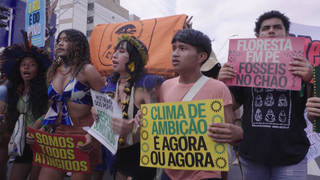

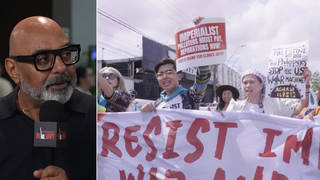
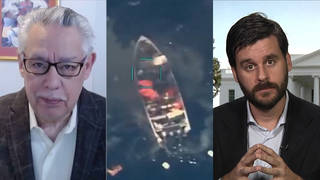





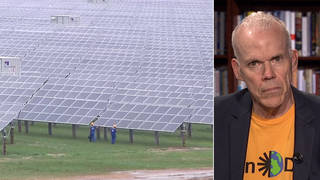
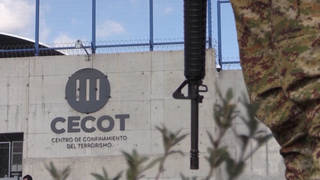
Media Options